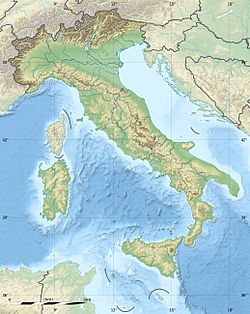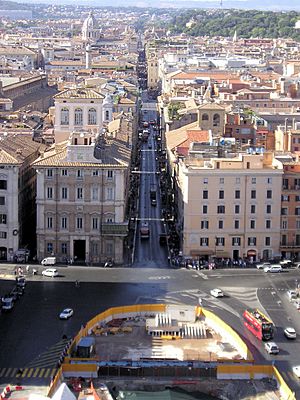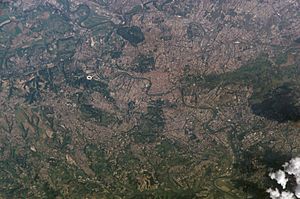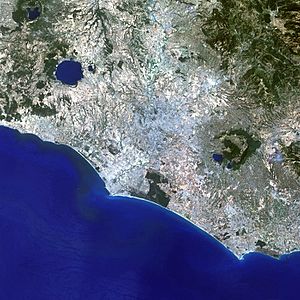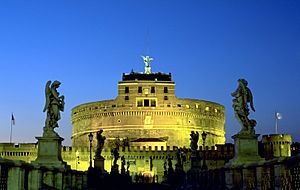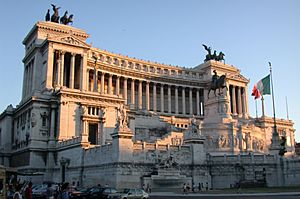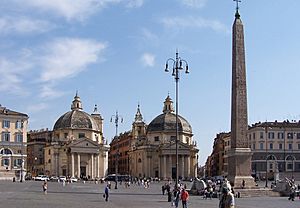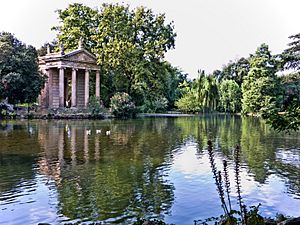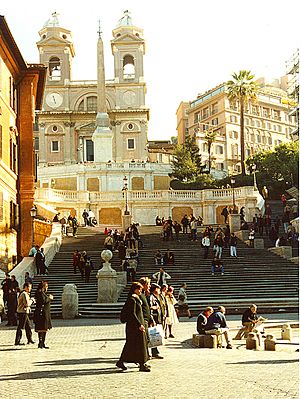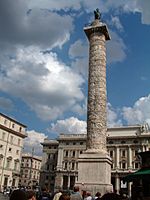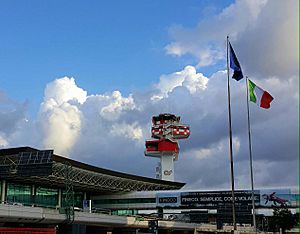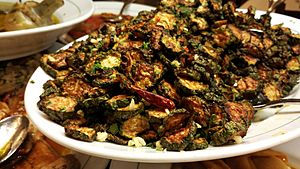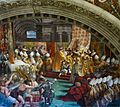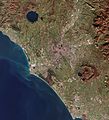Rome facts for kids
Quick facts for kids
Rome
Roma
|
|||||||||||||
|---|---|---|---|---|---|---|---|---|---|---|---|---|---|
|
Capital city and comune
|
|||||||||||||
| Roma Capitale | |||||||||||||
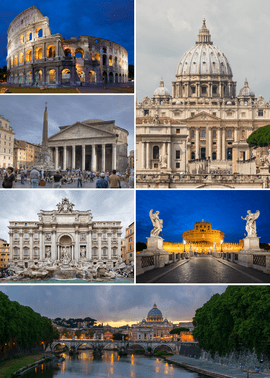
Clockwise from top: the Colosseum, St. Peter's Basilica, Castel Sant'Angelo, Ponte Sant'Angelo, Trevi Fountain and the Pantheon
|
|||||||||||||
|
|||||||||||||
| Etymology: Possibly Etruscan: Rumon, lit. 'river' | |||||||||||||
| Nickname(s): | |||||||||||||
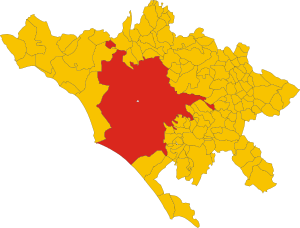
The territory of the comune (Roma Capitale, in red) inside the Metropolitan City of Rome (Città Metropolitana di Roma, in yellow). The white area in the centre is Vatican City.
|
|||||||||||||
| Country | |||||||||||||
| Region | |||||||||||||
| Metropolitan city | Rome | ||||||||||||
| Founded | 753 BC | ||||||||||||
| Founded by | King Romulus | ||||||||||||
| Government | |||||||||||||
| • Type | Strong Mayor–Council | ||||||||||||
| Area | |||||||||||||
| • Total | 1,285 km2 (496.3 sq mi) | ||||||||||||
| Elevation | 21 m (69 ft) | ||||||||||||
| Population
(31 December 2019)
|
|||||||||||||
| • Rank | 1st in Italy (3rd in the EU) | ||||||||||||
| • Density | 2,236/km2 (5,790/sq mi) | ||||||||||||
| • Comune | 2,860,009 | ||||||||||||
| • Metropolitan City | 4,342,212 | ||||||||||||
| Demonym(s) | Italian: romano (masculine), romana (feminine) English: Roman |
||||||||||||
| Time zone | UTC+1 (CET) | ||||||||||||
| CAP code(s) |
00100; 00118 to 00199
|
||||||||||||
| Area code(s) | 06 | ||||||||||||
| Website | comune.roma.it | ||||||||||||
|
|||||||||||||
Rome (in Italian and Latin: Roma) is the capital city of Italy. It is also the main city of the Lazio region. Rome has been a big city for nearly 3,000 years.
It is Italy's most populated city, with over 2.8 million people. It is also the third most populated city in the European Union. Rome is the center of the Metropolitan City of Rome, which has over 4.3 million people.
Rome is in the middle of Italy, along the Tiber River. Vatican City, the world's smallest country, is located inside Rome. This makes Rome unique, as it is a capital city that contains another country.
Rome's long history goes back 28 centuries. Ancient stories say Rome was founded around 753 BC. However, people lived there much earlier. This makes Rome one of Europe's oldest cities where people have lived continuously.
Contents
Rome's Long History
![]() Latins (Italic tribe) c. 2nd millennium – 753 BC
Latins (Italic tribe) c. 2nd millennium – 753 BC
![]() Albanis (Latins) 10th century – 753 BC
Albanis (Latins) 10th century – 753 BC
(Foundation of the city) 9th–c. BC
![]() Roman Kingdom 753–509 BC
Roman Kingdom 753–509 BC
![]() Roman Republic 509–27 BC
Roman Republic 509–27 BC
![]() Roman Empire 27 BC–285 AD
Roman Empire 27 BC–285 AD
![]() Western Roman Empire 285–476
Western Roman Empire 285–476
![]() Kingdom of Odoacer 476–493
Kingdom of Odoacer 476–493
![]() Ostrogothic Kingdom 493–553
Ostrogothic Kingdom 493–553
![]() Eastern Roman Empire 553–754
Eastern Roman Empire 553–754
![]() Papal States 754–1870
Papal States 754–1870
![]() Kingdom of Italy 1870–1946
Kingdom of Italy 1870–1946
![]() Vatican City 1929–present
Vatican City 1929–present
![]() Italian Republic 1946–present
Italian Republic 1946–present
No one knows for sure how ancient Rome was founded. A popular myth tells the story of twin brothers, Romulus and Remus. They were said to be raised by a she-wolf. Romulus killed Remus and became the first king of Rome. There is no historical proof for this story, but it is still very famous.
From Kingdom to Republic
After the Roman Kingdom ended, the Roman Republic began. The new Republic fought and took over lands around it. In 390 BC, the city was attacked by Gauls. Later, Rome fought against Carthage in big wars. The Roman army won and destroyed Carthage.
The Rise of Emperors
Rome grew a lot under Julius Caesar in the first century BC. His adopted son, Augustus, became the first emperor. Augustus famously said he "found a city of bricks and left it of marble". Later emperors added many new buildings, temples, and arches.
Decline and Papal Rule
As the Roman Empire weakened, Rome became less important. The city fell into ruin. The pope then began to rule Rome. It became the capital of the Papal States, which lasted until the 1800s. Popes, like emperors, became very rich. Rome was called the "capital of Christendom" because it was home to important churches.
In 1870, Giuseppe Garibaldi's army united Italy. They entered Rome, and the city became the capital of the new Italian state.
Rome Today
Rome is a major European center for politics and culture. It is home to the FAO, a part of the United Nations. Rome was one of the most powerful cities in the ancient world. Today, it has many museums, churches, and palaces, like the famous Colosseum.
Rome's Geography
Where is Rome Located?
Rome is in the Lazio region of central Italy. It sits on the Tiber River. The first settlement grew on hills near a shallow part of the river. The old city of Rome was built on seven hills: the Aventine Hill, Caelian Hill, Capitoline Hill, Esquiline Hill, Palatine Hill, Quirinal Hill, and Viminal Hill. Another river, the Aniene, also flows through modern Rome.
The city center is about 15 miles (24 km) from the Tyrrhenian Sea. However, Rome's territory reaches the coast, where the district of Ostia is located. The city of Rome covers about 496 square miles (1,285 km2). This includes many green areas.
How Rome is Laid Out
Historically, Rome's city limits were defined by its walls. The first walls were the Servian Wall, built after a Gaulish attack in 390 BC. Much later, in 270 AD, Emperor Aurelian built the Aurelian Walls. These walls were about 12 miles (19 km) long.
Today, Rome's urban area is divided by a ring-road called the Grande Raccordo Anulare (GRA). This road circles the city center about 6 miles (10 km) away. The comune (city area) of Rome is very large. It includes both busy city areas and large parks, nature reserves, and farmlands.
Rome's Climate
Rome has a Mediterranean climate. This means it has mild, wet winters and warm, dry summers.
The average temperature is above 68°F (20°C) during the day. At night, it's around 50°F (10°C). In January, the coldest month, the average daytime temperature is 54°F (12°C). At night, it's about 37°F (3°C). In July and August, the warmest months, the average daytime temperature is 86°F (30°C). At night, it's around 64°F (18°C).
Rome's Population
| Historical population | ||
|---|---|---|
| Year | Pop. | ±% |
| 1861 | 194,500 | — |
| 1871 | 212,432 | +9.2% |
| 1881 | 273,952 | +29.0% |
| 1901 | 422,411 | +54.2% |
| 1911 | 518,917 | +22.8% |
| 1921 | 660,235 | +27.2% |
| 1931 | 930,926 | +41.0% |
| 1936 | 1,150,589 | +23.6% |
| 1951 | 1,651,754 | +43.6% |
| 1961 | 2,188,160 | +32.5% |
| 1971 | 2,781,993 | +27.1% |
| 1981 | 2,840,259 | +2.1% |
| 1991 | 2,775,250 | −2.3% |
| 2001 | 2,663,182 | −4.0% |
| 2011 | 2,617,175 | −1.7% |
| 2017 | 2,876,051 | +9.9% |
| Source: ISTAT, 2001 | ||
In 550 BC, Rome was the second largest city in Italy. Some sources say its population was around 35,000 to 100,000 people. By 150 BC, it had more than 300,000 people.
The population of Rome changed a lot over time. After the Roman Empire declined, the city's population dropped. In the Early Middle Ages, it was less than 50,000 people. It stayed small until the Renaissance.
When the Kingdom of Italy took over Rome in 1870, the city had about 225,000 people. By World War I, it grew to 600,000. Even with efforts to control growth, Rome reached one million people in the early 1930s. After World War II, the population continued to grow quickly.
In 2010, Rome had over 2.7 million residents. About 4.2 million people lived in the greater Rome area. Children (under 18) made up 17% of the population. The average age of a Roman resident is 43.
People from Around the World
About 9.5% of Rome's population are not Italian citizens. Half of these immigrants are from other European countries. These include Romania, Poland, Ukraine, and Albania.
The other half are from non-European countries. Many are from the Philippines, Bangladesh, Peru, and China. The Esquilino area near Termini Railway Station is a diverse neighborhood. It is sometimes called Rome's Chinatown. However, people from over a hundred different countries live and work there.
Religion in Rome
Like most of Italy, Rome is mainly Roman Catholic. The city has been a very important religious center for centuries. It was once the heart of the ancient Roman Religion. Later, it became the home of the Vatican and the pope.
Before Christianity, the main religion in Rome was Religio Romana. Romans worshipped gods like Jupiter and Mars. They also honored goddesses like Vesta and Minerva. Rome also had several mystery cults, like Mithraism.
After St Peter and St Paul died in the city, Christianity grew. The first St. Peter's Basilica was built in 313 AD. For centuries, Rome has been the home of the Roman Catholic Church and the pope.
Rome's main church, or cathedral, is the Basilica of St. John Lateran. It is located southeast of the city center. Rome has about 900 churches in total. Other important churches include the Basilica di Santa Maria Maggiore and the Basilica of Saint Paul Outside the Walls. Underneath the city are the ancient Catacombs of Rome, which were underground burial places.
In recent years, Rome's Muslim community has grown. This is mainly due to people moving from North Africa and the Middle East. Rome built the largest mosque in Europe, which opened in 1995. Rome also has an important Jewish community. The main synagogue in Rome is the Tempio Maggiore.
Vatican City: A Country Inside Rome
Vatican City is a tiny independent country. It is located on the Vatican Hill within Rome. This is where St. Peter's Basilica, the Apostolic Palace, and the Sistine Chapel are found.
Vatican City became its own state in 1929 with the Lateran Treaty. Its borders are mostly defined by old walls and buildings. St. Peter's Square is part of Vatican City. It is separated from Italy by a white line on the ground. The famous Via della Conciliazione leads from the Tiber River to St. Peter's.
Rome's Cityscape
Rome's Architecture
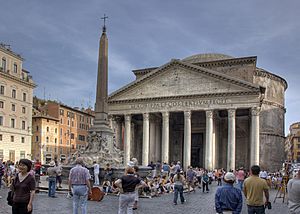
Rome's buildings have changed a lot over time. From ancient Roman styles to modern designs. Rome was a major center for classical architecture. They developed new forms like the arch, the dome, and the vault. Later, Rome became a key place for Renaissance and Baroque architecture.
Ancient Roman Buildings
The Colosseum (built 70–80 AD) is a famous symbol of Rome. It was the largest amphitheatre in the Roman Empire. It could hold 60,000 people and was used for gladiator fights.
Other important ancient Roman sites include:
- The Roman Forum
- The Domus Aurea
- The Pantheon
- Trajan's Column
- Trajan's Market
- The Catacombs
- The Circus Maximus
- The Baths of Caracalla
- Castel Sant'Angelo
- The Arch of Constantine
- The Pyramid of Cestius
Medieval Buildings
Rome also has many medieval buildings. Churches from early Christian times include Basilica di Santa Maria Maggiore and Basilica of Saint Paul Outside the Walls. These have beautiful mosaics from the 4th century AD. Other churches like Santa Maria in Trastevere also have medieval art.
Some medieval towers still stand, such as the Torre delle Milizie. There is also a large staircase leading to the Santa Maria in Ara Coeli church.
Renaissance and Baroque Buildings
Rome was a very important city during the Renaissance. Many grand palaces were built by rich families. These include the Palazzo del Quirinale and the Palazzo Farnese.
Many of Rome's famous squares got their current look during the Renaissance and Baroque periods. These include Piazza Navona, Piazza di Spagna, and Campo de' Fiori. The Fontana di Trevi is a famous example of Baroque art.
Neoclassical Buildings
In 1870, Rome became the capital of the new Kingdom of Italy. A building style called neoclassicism became popular. This style was inspired by ancient Roman buildings.
Many large palaces were built for government offices. A well-known example is the Monument to Vittorio Emanuele II. It is also called the "Altar of the Fatherland". It has the Grave of the Unknown Soldier, honoring Italians who died in World War I.
Parks and Gardens
Rome has many public parks and nature reserves. It has one of the largest green spaces among European capitals. Many of these green areas are old villas and gardens built by rich Italian families.
Some famous villas and gardens include Villa Borghese, Villa Ada, and Villa Doria Pamphili. Villa Doria Pamphili is a very large park. The Orto Botanico (Botanical Garden) in Trastevere is a cool, shady spot.
The Villa Borghese gardens are the most famous. They have art galleries and shaded walking paths. They are close to the Spanish Steps and Piazza del Popolo. Rome also has newer regional parks like the Pineto Regional Park.
Fountains and Aqueducts
Rome is famous for its many fountains. They come in different styles, from ancient to Baroque. Fountains have provided drinking water and decorated Rome's squares for over 2,000 years.
In ancient Roman times, nine aqueducts brought water to the city. These fed 39 large fountains and 591 public basins.
In the 17th and 18th centuries, popes rebuilt old aqueducts. They built new, grand fountains to show where the water ended. These fountains, like the Trevi Fountain, are examples of Baroque art. They are full of sculptures, emotion, and movement.
Statues
Rome is known for its many statues. Some are called "talking statues." These are old statues where people would leave notes. These notes often shared political or social opinions in a funny way.
The two main talking statues are the Pasquino and the Marforio. There are four others: il Babuino, Madama Lucrezia, il Facchino, and Abbot Luigi. Most of these statues are ancient Roman. They often show mythical gods or historical figures. People still put placards or graffiti on them with their ideas.
Other famous statues include those on the Ponte Sant'Angelo. There is also a monument to Giordano Bruno in the Campo de'Fiori.
Obelisks and Columns
Rome has eight ancient Egyptian obelisks and five ancient Roman ones. There are also newer obelisks. You can find them in squares like Piazza Navona and St. Peter's Square. Others are in parks and gardens.
Rome also has two famous ancient Roman columns with carvings that spiral up them. These are Trajan's Column and the Column of Marcus Aurelius.
Bridges
Rome has many famous bridges crossing the Tiber River. Some well-known ones include the Ponte Cestio, the Ponte Milvio, and the Ponte Sant'Angelo.
Five ancient Roman bridges still stand in the city. Most of Rome's public bridges were built in Classical or Renaissance styles. The Ponte Sant'Angelo, finished in 135 AD, is considered one of the finest ancient bridges. It is decorated with 10 statues of angels.
Catacombs
Rome has many ancient catacombs. These are underground burial places found under or near the city. There are at least forty of them. Most are known for Christian burials. However, some also contain pagan and Jewish burials.
The first large catacombs were dug starting in the 2nd century. They were carved out of soft volcanic rock outside the city. This was because Roman law did not allow burials inside city limits. Today, the Papacy looks after the catacombs.
Rome's Economy
In 2019, Rome was the 11th most visited city in the world. It had 10.1 million tourists. It was the third most visited city in the European Union. Rome's historic center is a UNESCO World Heritage Site.
Rome hosted the 1960 Summer Olympics. It is also home to several United Nations agencies. These include the Food and Agriculture Organization (FAO) and the World Food Programme (WFP).
Many international companies have their main offices in Rome. These include Eni, Enel, and TIM. Large banks like Unicredit are also there.
The EUR business district in Rome is home to companies in oil, medicine, and finance. Rome is also a big center for fashion and design. The Cinecittà Studios have been used to film many Academy Award-winning movies.
Transportation in Rome
Rome has an airport called Leonardo Da Vinci International Airport (FCO). The city also has two subway lines, called "Underground A" and "Underground B". There are also many bus routes throughout the city.
Roman Cuisine

Rome's food has changed over many centuries. In ancient times, Roman food was influenced by ancient Greek culture. As the empire grew, Romans learned new cooking styles from other places.
During the Renaissance, Rome became known for its fancy food. Some of the best chefs worked for the popes. For example, Bartolomeo Scappi was a chef for Pope Pius IV. He published a cookbook in 1570 with about 1,000 recipes.
The Testaccio area was home to butchers. The traditional Roman food often used less common parts of animals. Coda alla vaccinara (oxtail cooked like butchers do) is still a popular dish. Lamb is also very popular and often roasted with herbs.
Modern Roman food uses ingredients from the nearby countryside. Globe artichokes are common. Roman Jews, who have been in the city since the 1st century BC, also developed their own unique food style.
Some examples of Roman dishes include:
- "Saltimbocca alla Romana" – veal with ham and sage, cooked with white wine.
- "Carciofi alla romana" – artichokes stuffed with mint, garlic, and breadcrumbs.
- "Carciofi alla giudia" – artichokes fried in olive oil, a Jewish Roman dish.
- "Spaghetti alla carbonara" – spaghetti with bacon, eggs, and pecorino cheese.
- "Gnocchi di semolino alla romana" – semolina dumplings.
Related pages
Images for kids
-
Roman representation of the god Tiberinus, Capitoline Hill in Rome
-
Capitoline Wolf, a sculpture of the mythical she-wolf suckling the infant twins Romulus and Remus
-
The Ancient-Imperial-Roman palaces of the Palatine, a series of palaces located in the Palatine Hill, express power and wealth of emperors from Augustus until the 4th century.
-
The Roman Forum are the remains of those buildings that during most of Ancient Rome's time represented the political, legal, religious and economic centre of the city and the neuralgic centre of all the Roman civilisation.
-
Trajan's Column, triumphal column and place where the relics of Emperor Trajan are placed
-
15th-century illustration depicting the Sack of Rome (410) by the Visigothic king Alaric I
-
Detail view on an illustration by Raphael portraying the crowning of Charlemagne in Old Saint Peter's Basilica, on 25 December 800
-
Castel Sant'Angelo, or Hadrian's Mausoleum, is a Roman monument radically altered in the Middle Ages and the Renaissance built in 134 AD and crowned with 16th and 17th-century statues.
-
Fontana della Barcaccia by Gian Lorenzo Bernini in 1629
-
Carnival in Rome, c. 1650
-
Bombardment of Rome by Allied planes, 1943
-
The Pantheon, built as a temple dedicated to "all the gods of the past, present and future"
-
The Colosseum is still today the largest amphitheater in the world. It was used for gladiator shows and other public events (hunting shows, recreations of famous battles and dramas based on classical mythology).
-
The Trevi Fountain. Construction began during the time of Ancient Rome and was completed in 1762 by a design of Nicola Salvi.
-
Fontana dei Fiumi by Gian Lorenzo Bernini, 1648
-
The Vatican Museums are the 3rd most visited art museum in the world.
-
Sepulchral inscription for Tiberius Claudius Tiberinus, a Plebeian and professional declaimer of poetry. 1st century AD, Museo Nazionale Romano.
-
Stadio Olimpico, home of A.S. Roma and S.S. Lazio, is one of the largest in Europe, with a capacity of over 70,000.
-
FAO headquarters in Rome, Circo Massimo
-
WFP headquarters in Rome
See also
 In Spanish: Roma para niños
In Spanish: Roma para niños




